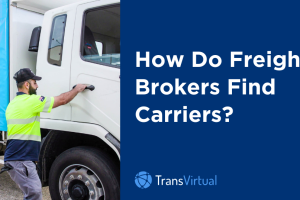Table of Contents
Competition among freight brokers is intense. But the market is growing rapidly and expected to reach $14B at a 36% growth rate by 2028.
Simply put, there are opportunities out there, you just need to be savvy and strategic about it!
One strategy at the forefront is digital freight matching. It’s revolutionizing the industry through AI, machine learning, and predictive analysis to optimize matches in terms of efficiency, capacity, and costs. But that’s just the tip of the iceberg.
So, how do freight brokers find carriers? What strategies are they applying and how do you get started? Here’s what you need to know.
How to Find Freight Carriers: Tips for Brokers
For Freight Brokers, Everything begins with Relationship Building
Freight brokers act as essential intermediaries between shippers and carriers. Your growth relies on constantly finding customers and maintaining a steady stream of business.
To find freight carriers, you’ll need to forge strong relationships with both shippers and carriers. The needs of shippers include reliable transportation, cost-effective solutions, efficient communication, and flexibility on security. Carriers, on the other hand, require consistent loads, fair compensation, efficient scheduling, and support.
Above all, as a freight broker, you need to demonstrate that you can provide reliable, cost-efficient solutions alongside clear communication and flexibility. Maintaining positive relationships with trusted carrier partners is crucial for ensuring consistent and dependable service.
Start with shippers
Finding shippers is generally harder than finding loads. Shippers represent the customer base and securing their business often requires building trust, demonstrating reliability, and offering competitive rates.
Begin with networking. Make your brand known in the community by attending industry events like FrieghtWaves Live, or TIA Capital Ideas Conference & Exhibition to develop strong in-person relationships.
In addition, an online presence is essential. Shippers should be able to easily find you through active social media and websites. Likewise, cold calling and outreach is still a valuable strategy especially if you have a solid performance record behind your company.
Finding loads on load boards
Once a broker has a solid network of shippers, finding loads becomes more manageable, especially with the help of online load boards and logistics software. Efficiently covering loads is crucial for improving the percentage of loads covered and directly impacts the profitability of freight brokers.
Let’s start with Load boards. These are online platforms where shippers post available loads, allowing brokers to find suitable matches quickly and efficiently. These platforms are essential tools for brokers to streamline their load-finding process.
Examples include DAT Load Board, which offers a comprehensive database with real-time updates and advanced search options. Truckstop also provides access to a vast network of loads and trusted freight carriers, featuring load matching and rate analysis tools. Another option is 123Loadboard, which offers a user-friendly interface with features like load alerts, credit reports, and mileage calculations.
Next, no freight broker can exist today without logistics software, which offer real-time information about available loads and automates crucial aspects of load management, such as matching loads with carriers and tracking shipments efficiently. This integration enhances operational decision-making capabilities significantly.
Freight Carrier Networks and market intelligence: the final puzzle pieces
Once you’ve established your customer base of shippers and found loads, it’s critical to maintain a diverse network of reliable carriers.
Utilizing effective carrier sourcing methods is essential when the initial search does not yield results. This is key for finding the right transport solution for different load types. Moreover, brokers often use these relationships to secure capacity for new loads by searching through the entire carrier base in their transport management system (TMS).
For example, this could include being able to quickly source a refrigerated truck for perishable goods or a flatbed for oversized machinery. By ensuring you can meet specific needs like these, you’ll secure capacity for new loads. Digital freight matching can further streamline this process by utilizing AI and machine learning to optimize matches in real-time freight marketplaces.
Finally, as with any reliable carrier, market intelligence is vital. Understanding market trends and demands allows brokers to anticipate when and where loads will be available. By analyzing seasonal patterns, economic indicators, and industry-specific developments, brokers can identify peak times for certain types of shipments and regions with high demand. This knowledge enables them to proactively contact shippers with tailored solutions before loads are posted on public platforms. Tracking services within digital freight matching apps provide real-time insight into the location of capacity, optimizing matches in terms of efficiency, capacity, and costs.
For instance, knowing that agricultural produce spikes during the harvest season in specific areas allows brokers to secure transportation for these loads in advance, ensuring timely delivery and better rates for both shippers and carriers. This proactive approach helps avoid the inefficiency of manually calling carriers one by one to determine truck capacity.
Drive forward with a technology-driven, market-first approach in the trucking industry
Success in finding shippers and loads centers on forging long-term partnerships, and leveraging technology, networking, and market intelligence.
By leveraging advanced, cloud-based logistics software, brokers can streamline their operations, enhance security, and stay competitive in a dynamic market by connecting with trusted carrier partners. The ability to access real-time data, automate processes, and maintaining strong relationships with shippers and carriers will all help you better compete, win new business, and strengthen existing relationships.
Fast-track your success. Start leveraging Transvirtual software now to integrate with hundreds of carriers, boost efficiency, and better unlock what digital tools can do for you.



